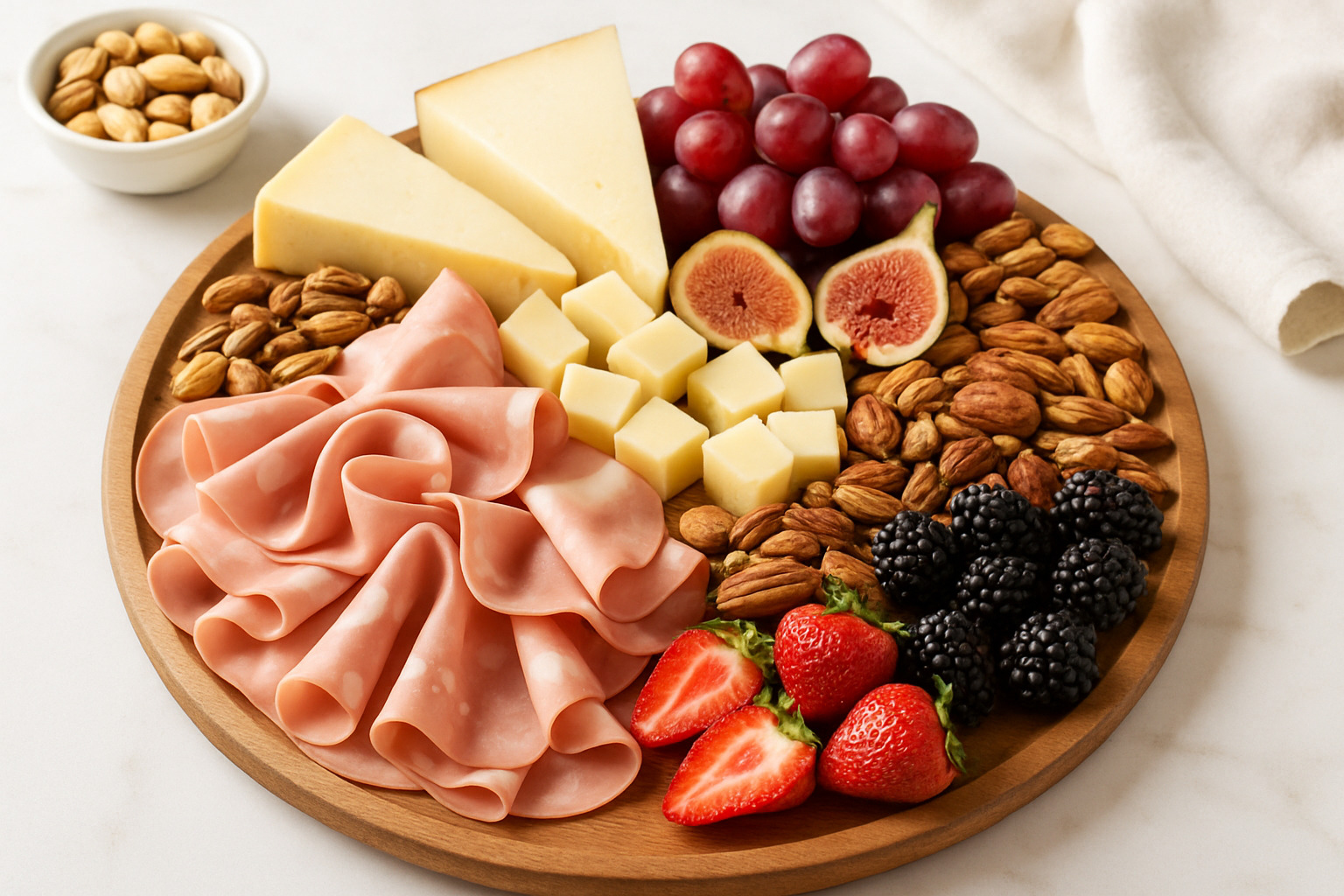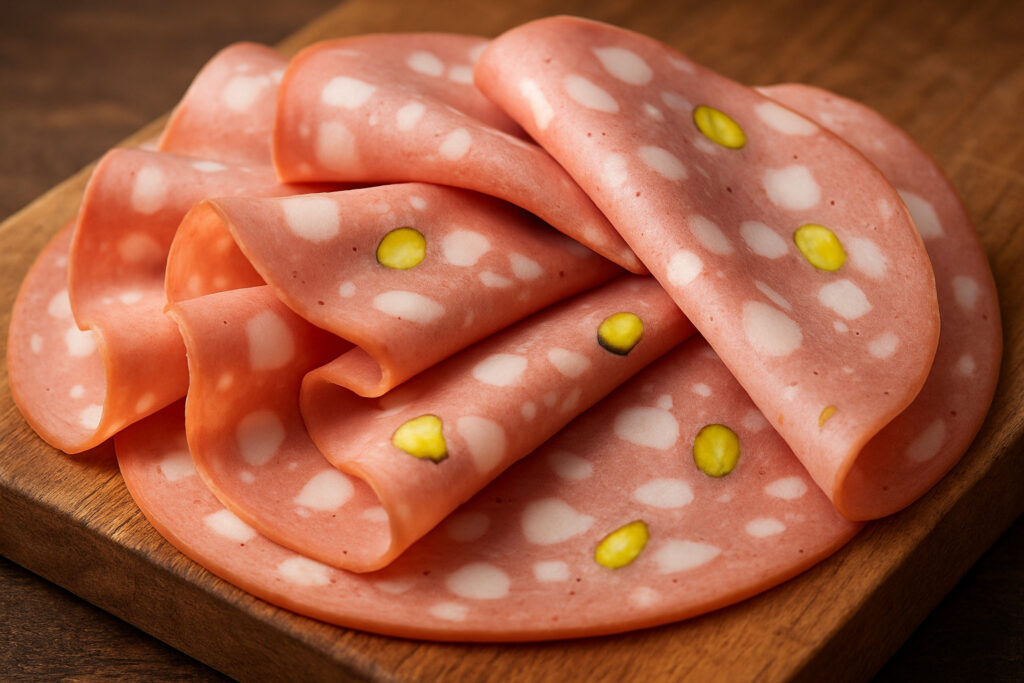Why Mortadella Deserves a Spot on Every Foodie’s Radar
Mortadella is an Italian cured pork sausage that’s having a major moment in kitchens and restaurants worldwide. This silky, pink-hued delicacy studded with white fat cubes might look like fancy bologna, but it’s actually a centuries-old culinary masterpiece from Bologna, Italy.
Quick Facts About Mortadella:
- What it is: Finely ground pork sausage with at least 15% visible fat cubes
- Origin: Bologna, Italy (dating back to 1376)
- Taste: Rich, nutty pork flavor with a velvety texture
- Key ingredients: Pork, pork fat, black pepper, often pistachios
- Protected status: Mortadella Bologna carries PGI (Protected Geographical Indication) certification
- Calories: 288 per 100 g with 15 g protein
For food lovers seeking authentic culinary experiences, mortadella represents the perfect intersection of tradition and innovation. Once reserved for Italian nobility due to its high cost, this delicate charcuterie has evolved into a versatile ingredient that’s capturing attention from New York City delis to Vietnamese bánh cuốn stalls.
The white “polka dots” you see in each slice aren’t just decorative – they’re carefully cubed pork fat that melts on your tongue, creating mortadella’s signature creamy mouthfeel. Unlike mass-produced lunch meats, authentic mortadella follows strict traditional methods that have been refined over 600 years.
Whether you’re planning your next culinary trip or simply want to lift your charcuterie game, understanding mortadella opens doors to a world of flavors that bridges ancient Roman recipes with modern sustainable dining trends.
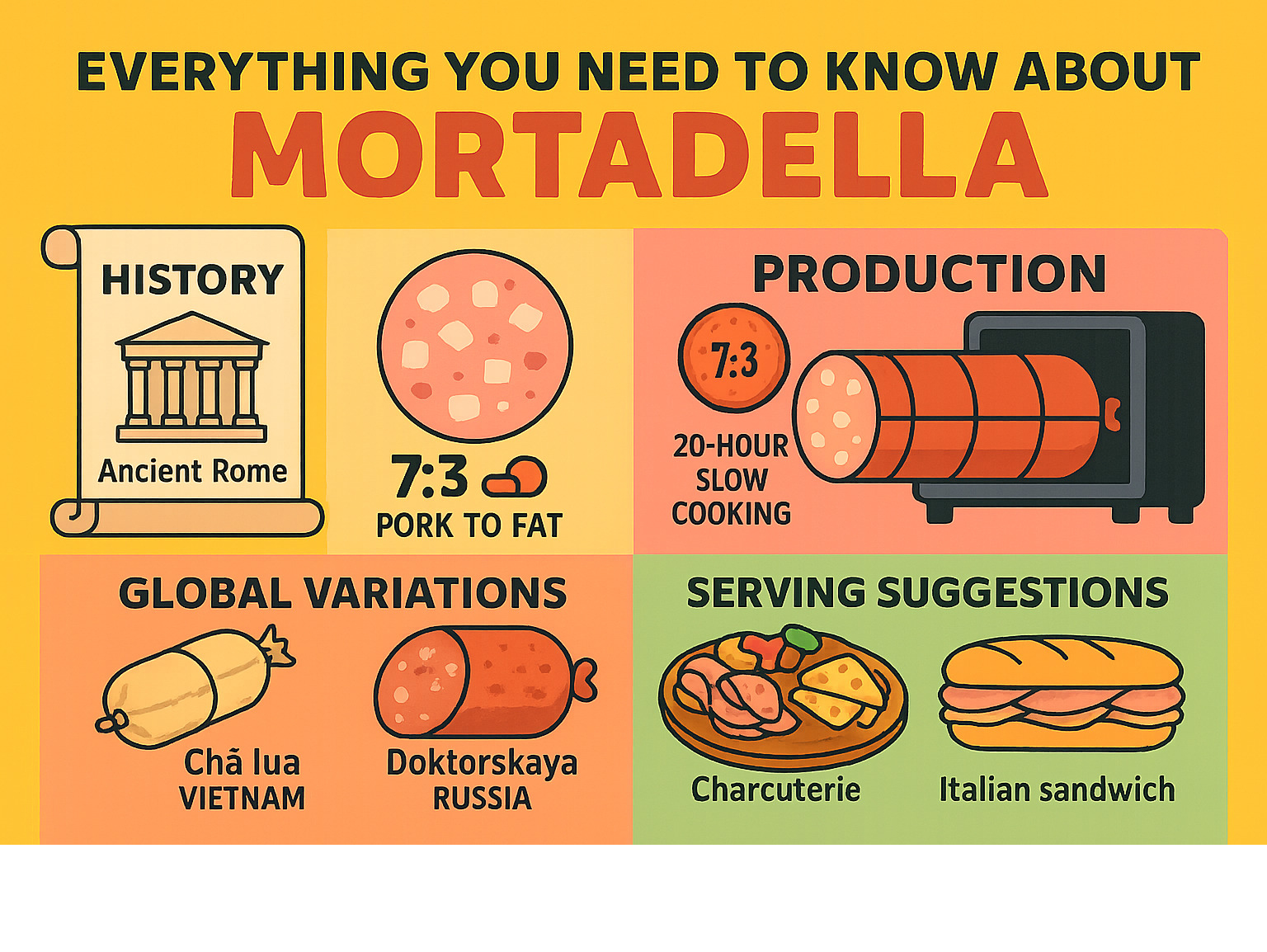
Mortadella basics:
What Is Mortadella? Definition & Key Traits
Mortadella is Italy’s crown jewel of charcuterie—a large, cylindrical pork sausage that’s both ancient and surprisingly modern. Picture slicing into a smooth, pink cylinder and revealing a beautiful mosaic of creamy white fat cubes scattered throughout like edible confetti. Those aren’t just pretty decorations; they’re the secret to mortadella’s legendary silky texture.
The magic happens in the details. True mortadella contains at least 15% visible fat cubes called lardelli, which are carefully diced from the pig’s neck or throat. When you bite into a slice, these fat cubes literally melt on your tongue, creating that luxurious mouthfeel that makes mortadella so addictive.
Black peppercorns dot the pink landscape, adding gentle spice, while pistachios make frequent guest appearances (though they’re not required for authentic mortadella). The whole thing comes wrapped in a distinctive cylindrical shape that can range from a modest 500 grams to an impressive 100 kilograms—imagine the sandwich possibilities!
What sets authentic mortadella apart is its PGI seal (Protected Geographical Indication). This isn’t just a fancy sticker; it’s a guarantee that your mortadella follows centuries-old traditions from Bologna, Italy, where this delicacy was first perfected.
The texture is where mortadella truly shines. Unlike other deli meats that can feel dense or rubbery, quality mortadella has an almost velvety bite that seems to dissolve on your palate, releasing rich pork flavors with subtle nutty notes.
Mortadella vs. Bologna: Key Differences
Here’s where things get interesting—and a little confusing. American bologna and Italian mortadella are like distant cousins who took very different life paths.
The key difference lies in emulsification. American bologna blends everything into a smooth, uniform paste, while mortadella celebrates those visible lardelli fat cubes. It’s the difference between a smooth jazz performance and a symphony with distinct instruments you can actually hear.
Mortadella brings complex spices and aromatics to the party—think myrtle berries, coriander, and anise alongside the classic black pepper. Bologna keeps things simple, almost bland by comparison. The mouthfeel tells the whole story: mortadella melts luxuriously on your tongue, while bologna has a firmer, more uniform texture.
Then there’s the aroma. Walk past a good Italian deli when they’re slicing fresh mortadella, and you’ll catch those nutty, peppery notes that make your mouth water. Bologna? Not so much.
Think of it this way: if bologna is a reliable sedan, mortadella is a vintage Italian sports car—both will get you where you’re going, but the experience is completely different.
Want to showcase mortadella properly? Check out our Charcuterie Board Ideas for inspiration.
Origins & Protected Status
The story of mortadella begins in the busy markets of ancient Rome, where butchers crafted a spiced sausage called farcimen myrtatum. This early ancestor was flavored with aromatic myrtle berries and ground using a stone mortar called a mortarium – which many food historians believe gave mortadella its distinctive name.
But the real magic happened in medieval Bologna. In 1376, the city’s meat preservers’ guild first officially documented mortadella production, establishing the foundation for what would become one of Italy’s most celebrated charcuterie traditions. These guild artisans weren’t just making sausage – they were creating edible art that would define Italian cuisine for centuries.
The turning point came in 1661 when Cardinal Farnese issued his famous “Bando e Tariffa” decree. This wasn’t just bureaucratic paperwork – it was a food quality standard that laid out precise rules for mortadella production. The Cardinal understood something modern food lovers appreciate: authenticity matters, and great food deserves protection.
Fast-forward to 1998, when the European Union recognized Mortadella Bologna with coveted PGI (Protected Geographical Indication) status. This means that only mortadella made in specific Italian regions, following traditional methods and recipes, can legally bear the prestigious Mortadella Bologna name. It’s like a passport for your palate, guaranteeing the real deal.
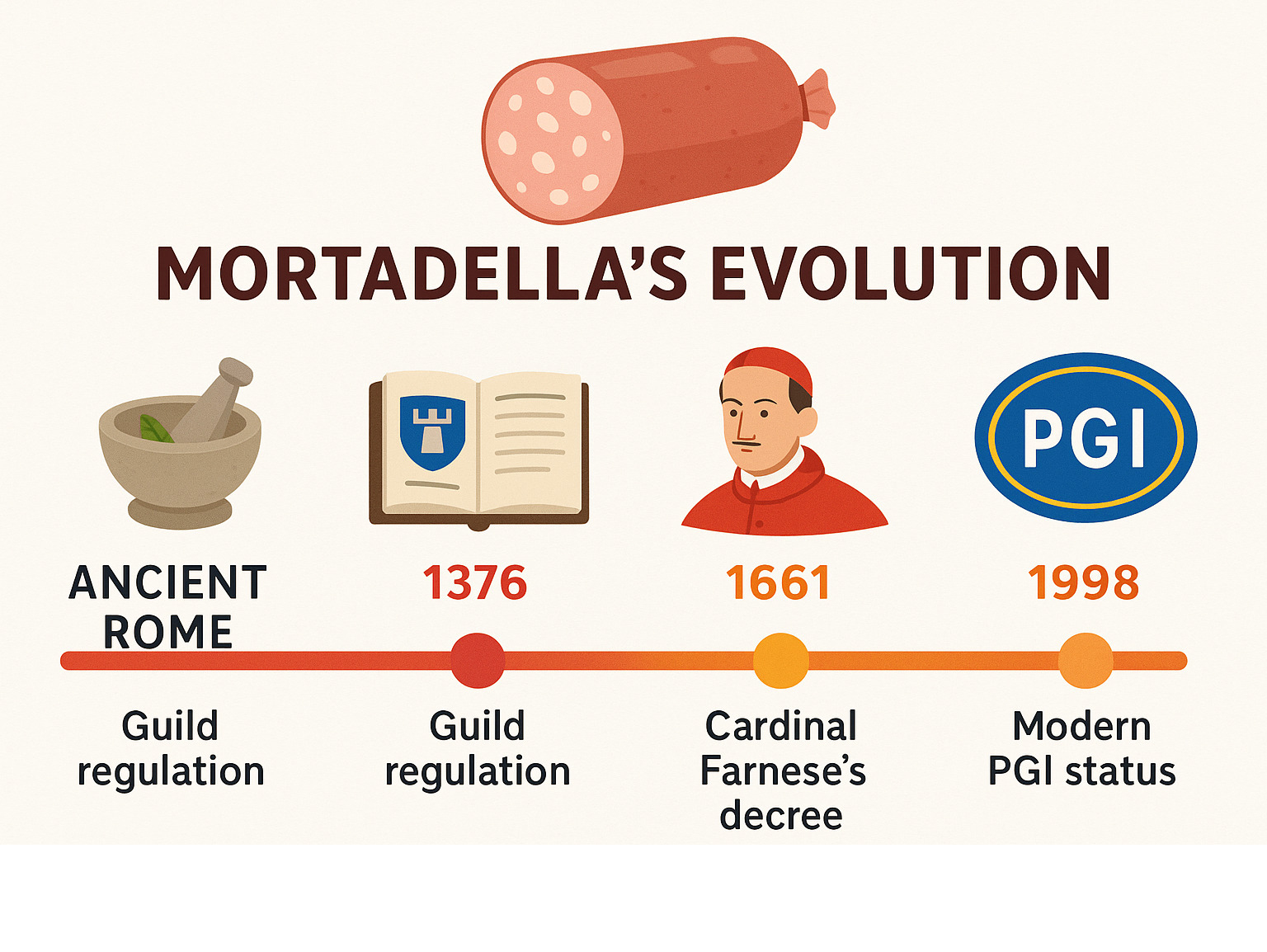
The Birth of Mortadella Bologna (PGI)
Today’s most prestigious mortadella carries the Mortadella Bologna PGI seal – a badge of honor overseen by the Consorzio Mortadella Bologna. These guardians of tradition ensure that every authentic PGI mortadella uses only select pork cuts and pork neck fat, maintains the perfect 7:3 meat-to-fat ratio, and may include those beloved pistachios that are especially popular in central and southern Italy.
You’ll recognize authentic PGI mortadella by its official wax seal or official PGI marking – your guarantee that this isn’t just any deli meat, but a product rooted in centuries of Emilia-Romagna heritage. When you see these authenticity markers, you’re not just buying lunch – you’re investing in a piece of culinary history.
Global Spread & Adaptations
Mortadella’s irresistible appeal couldn’t stay contained within Italy’s borders. In São Paulo, Brazil, the giant mortadella sandwich has become legendary among locals and food tourists alike. Vietnamese cuisine adopted chả lụa, a delicate pork sausage inspired by mortadella’s silky texture.
Russian and Eastern European countries developed their own interpretations, including “Doktorskaya” sausage, often with milder flavors adapted to local tastes. The Middle East created halal versions using turkey, beef, or chicken, proving that great food ideas transcend cultural boundaries.
The United States has its own mortadella story – imports were banned from 1967 to 2000 due to disease concerns. But once the ban lifted, authentic mortadella quickly found its way back into the hearts (and stomachs) of American food lovers, especially in New York City’s vibrant Italian deli scene.
For those curious about the nutritional science behind this beloved charcuterie, scientific research on pork fat reveals some surprising insights about this traditional ingredient.
How Mortadella Is Made: From Pig to Pink Perfection
Creating authentic mortadella is like watching culinary magic unfold. This isn’t your typical sausage-making process—it’s a delicate dance between tradition and precision that transforms simple pork into Italy’s most neat charcuterie.
The secret lies in the 7:3 pork-to-fat ratio that gives mortadella its signature richness. Master producers start with the finest cuts of pork shoulder and back, then carefully select creamy neck and throat fat that will become those iconic white cubes, or lardelli, scattered throughout each slice like edible confetti.
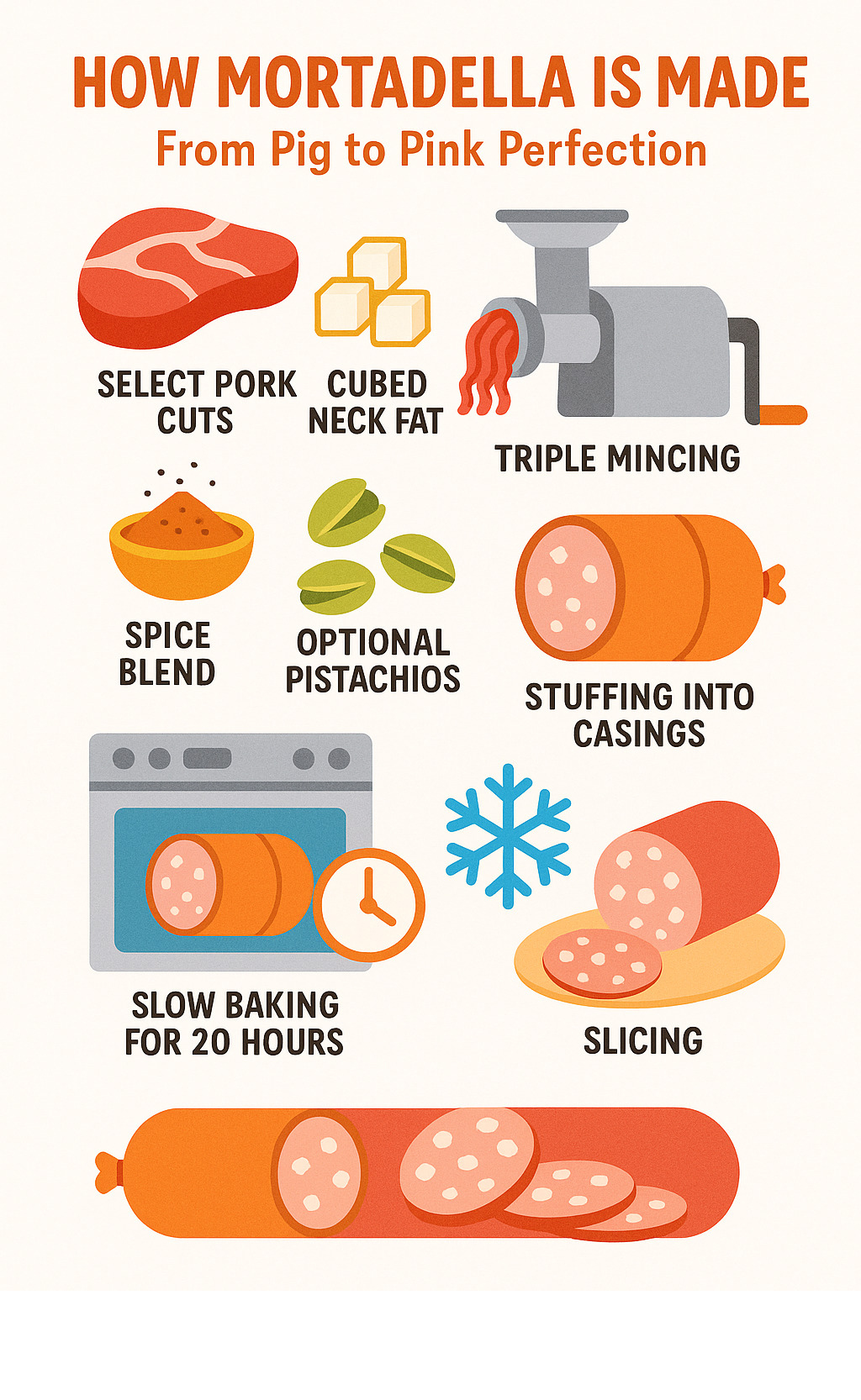
The magic happens during triple emulsification—the pork gets ground not once, not twice, but three times until it reaches a silky-smooth paste that would make any food processor jealous. Meanwhile, those precious fat cubes are gently folded in by hand, ensuring they stay perfectly intact for that classic polka-dot appearance.
Next comes the spice blend, where black pepper takes center stage alongside aromatic companions like coriander and myrtle berries. Pistachios are optional but beloved, especially in central and southern Italy, adding their distinctive green flecks and nutty crunch to the mix.
Once everything is perfectly combined, the mixture gets stuffed into massive casings—some weighing up to 100 kilograms! These giant sausages then start on a 20-hour slow baking journey in specialized steam ovens, cooking gently at precisely controlled temperatures to develop that characteristic pink hue and velvety texture.
The final step? A refreshing cold water shower followed by a patient resting phase that allows all those flavors to meld into mortadella’s distinctive taste profile.
For authentic Italian mortadella insights, explore Mortadella – Salumi Italiani.
Selecting Meat & Fat Cubes
The best mortadella starts with the best ingredients, and that often means Mora Romagnola pigs—a heritage breed prized for its exceptional flavor and marbling. These aren’t your average pork chops; we’re talking about carefully selected cuts that have been raised specifically for charcuterie.
The fat selection is equally crucial. Producers hand-dice the clean throat fat into perfect cubes, then rinse and inspect each piece for purity. It’s meticulous work that separates artisan mortadella from mass-produced alternatives.
Temperature control becomes critical at this stage. Everything stays ice-cold, sometimes even lightly frozen, to prevent the fat from smearing during processing. This attention to detail ensures those beautiful white cubes remain distinct and intact in every slice.
The Emulsification & Cooking Process
Centuries ago, mortadella earned its name from the mortar tradition—literally pounding pork with a pestle until it reached the perfect consistency. Today’s producers honor that heritage using sophisticated three-step grinding systems and advanced mixers, but the goal remains the same: achieving that impossibly smooth emulsion.
Once the mixture is stuffed into its casing, the real patience begins. Industrial steam ovens work their magic over nearly a full day, maintaining precise temperatures that cook the mortadella through without compromising its delicate texture.
The water-shower cooling that follows might seem dramatic, but it’s essential for stopping the cooking process at exactly the right moment. Then comes the resting phase—a quiet period where the mortadella develops its full aroma and that distinctive flavor that makes it so much more than just fancy lunch meat.
Taste, Nutrition & Dietary Insights
When you take your first bite of authentic mortadella, you’ll understand why it’s been captivating taste buds for centuries. The flavor is rich and savory, with that distinctive pork taste liftd by gentle spicing. If your mortadella includes pistachios, you’ll notice a lovely nutty undertone that adds complexity without overwhelming the meat.
But it’s the texture that really sets mortadella apart. Those white fat cubes aren’t just for show—they melt on your tongue as you chew, creating an incredibly velvety, creamy mouthfeel that’s both indulgent and refined. It’s like the difference between a mass-produced chocolate bar and artisanal truffle.
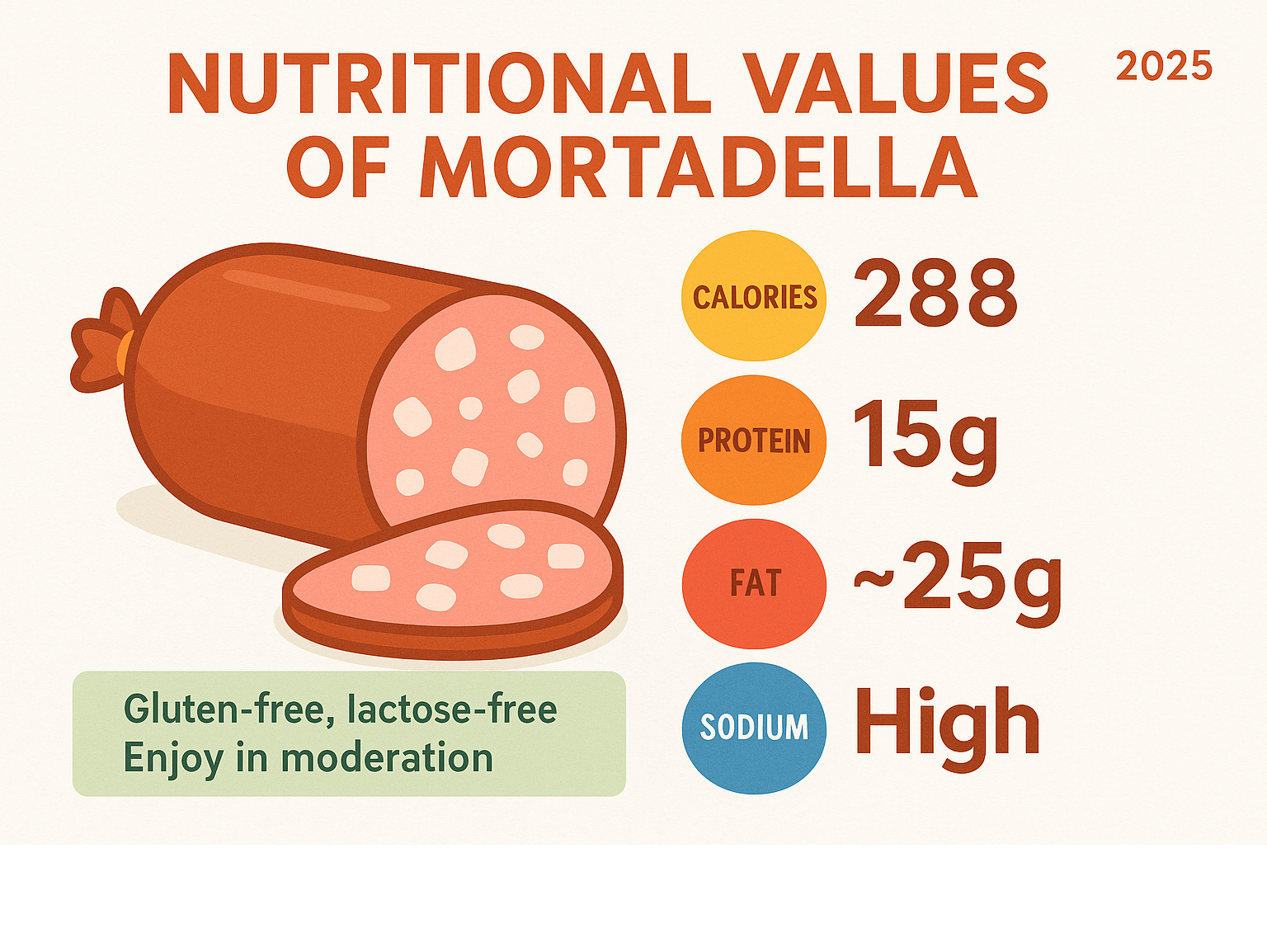
From a nutritional standpoint, mortadella delivers 288 calories per 100 grams with a solid 15 grams of protein. The fat content sits around 25 grams, but here’s the surprising part—most of it is unsaturated fat, similar to what you’d find in olive oil. This makes it quite different from many processed lunch meats.
Good news for those with dietary restrictions: quality mortadella is typically gluten-free and lactose-free. Many reputable producers now make versions without artificial preservatives, trans fats, or unnecessary fillers. The main thing to watch is sodium content, which can be high, so moderation is key if you’re monitoring your salt intake. For more insights on sodium and health, check out this scientific research on sodium intake.
Is Mortadella Healthy?
Let’s be honest—mortadella isn’t exactly a superfood, but it’s not the dietary villain some people think it is either. The cholesterol levels are actually comparable to chicken, and that fat content we mentioned? It’s largely the good kind of fat your body can actually use.
Modern artisanal mortadella often comes free of artificial preservatives and sketchy fillers that plague mass-market deli meats. It’s genuinely protein-rich and can absolutely fit into a balanced diet. The trick is portion control—a few thin slices on a charcuterie board or in a sandwich won’t derail your healthy eating goals.
If you’re watching your sodium intake, look for premium brands that use traditional curing methods with less salt, or simply enjoy smaller portions paired with fresh fruits and vegetables.
Pairings & Beverage Matches
Mortadella is practically made for entertaining. Its gentle spice and smooth texture make it incredibly versatile on a charcuterie board.
Try pairing it with a Chianti or Lambrusco—those Italian reds complement the pork beautifully without overpowering the delicate spicing. For something different, a fruity French wine works wonderfully too.
On the food side, fresh pistachios echo the nutty notes if your mortadella includes them. Figs add natural sweetness that balances the savory richness, while a drizzle of honey creates an absolutely divine combination. Don’t forget crusty bread to tie everything together.
For a creamy contrast, try pairing mortadella with mascarpone—the tangy richness creates a perfect counterpoint to the meat’s smooth texture. It’s one of those combinations that just makes sense once you try it.
Buying, Storing & Serving Mortadella
Ready to experience authentic mortadella in your own kitchen? The good news is that this Italian delicacy is more accessible than ever, especially if you know where to look and how to handle it properly.
Finding quality mortadella starts with knowing your sources. Your best bet is heading to the deli counter at a well-stocked grocery store or Italian specialty market. Ask specifically for “Mortadella Bologna” and don’t be shy about requesting a taste—good mortadella should have that signature creamy texture and rich, nutty flavor. You can choose between the classic version or one studded with pistachios, depending on your preference.
For the most authentic experience, seek out specialty grocers that import directly from Italy. These shops often carry mortadella with the coveted PGI seal, guaranteeing you’re getting the real deal. If you’re in New York City, you’re in luck—the city’s Italian markets and established delis are treasure troves for charcuterie lovers.
Online ordering has also opened up a world of possibilities, allowing you to access premium mortadella from artisanal producers that might not be available locally.
Once you’ve brought your mortadella home, proper storage is key to maintaining its delicate flavor and silky texture. Keep it refrigerated between 35–39°F, and always wrap it tightly or store it in an airtight container to prevent it from drying out. The enemy of good mortadella is exposure to air, which can make it lose that prized creaminess.
Plan to consume your mortadella within 7 days of opening for the best experience. While freezing is possible, it may slightly change the texture—if you do freeze it, slice or portion it first for easier use later.
Explore more: Italian Restaurants Near Me
Recipes You’ll Love
Mortadella truly shines when you move beyond simple sandwiches and explore its versatility in the kitchen. The muffuletta, that beloved New Orleans creation, showcases mortadella beautifully—layered with ham, salami, cheese, and tangy olive salad on a round Italian loaf. It’s a sandwich that transforms mortadella into something truly special.
For an neat appetizer, try spuma di mortadella—a whipped mortadella mousse that spreads like silk on crostini. This preparation highlights the sausage’s creamy nature while creating something that feels restaurant-worthy.
Traditional Italian cooks know that mortadella is essential in authentic tortellini filling, combined with pork, prosciutto, Parmigiano, and a touch of nutmeg. This classic use shows how mortadella adds depth and richness to pasta dishes.
Looking for something more casual? Try fried mortadella cutlets—thick slices breaded and fried until golden. It’s comfort food that transforms this neat charcuterie into a satisfying snack. You can even dice mortadella and fold it into creamy rigatoni dishes for an unexpected twist on pasta night (see Rigatoni).
Pizza lovers shouldn’t overlook mortadella as a topping—thin strips crisped in the oven add a sophisticated element that lifts homemade pizza beyond the ordinary.
Crafting a Mortadella Charcuterie Board
Creating a mortadella charcuterie board is where this Italian treasure truly gets to show off. The key is treating mortadella with the respect it deserves—arrange thin ribbons of it alongside other premium charcuterie like prosciutto and salami, allowing its delicate pink color and distinctive white fat dots to create visual interest.
Fresh and dried fruits provide the perfect sweet counterpoint to mortadella’s rich, savory notes—think ripe figs, crisp pears, or plump grapes. Toasted nuts and honey echo the pistachio notes found in some mortadella varieties, while olives and pickles add the acidic brightness that cuts through the richness.
Don’t forget a dab of grain mustard and plenty of crusty bread or focaccia for building the perfect bite. The goal is creating a board where mortadella can shine alongside complementary flavors without being overwhelmed.
Get inspired with more Charcuterie Board Ideas.
Mortadella Around the World: Varieties & Trivia
While Bologna’s mortadella remains the gold standard, this beloved sausage has inspired fascinating variations across Italy and beyond. Each region has put its own spin on the classic recipe, creating a delicious family of mortadella-style charcuterie.
In Tuscany, Mortadella di Prato takes a completely different approach. This garlic-scented version gets its distinctive pink color from alchermes liqueur, making it as visually striking as it is flavorful. Meanwhile, down in Abruzzo, the charming Mortadella di Campotosto comes in adorable heart shapes and carries a gentle smoky flavor that sets it apart from its Bolognese cousin.
For the truly adventurous, some Italian regions still produce horse-meat mortadella—a rare specialty that speaks to the deep historical roots of Italian charcuterie traditions. And then there’s the great pistachio debate: classic versus pistachio mortadella. Purists argue that the original recipe needs no embellishment, while others swear by those bright green nuts that add both flavor and visual appeal.
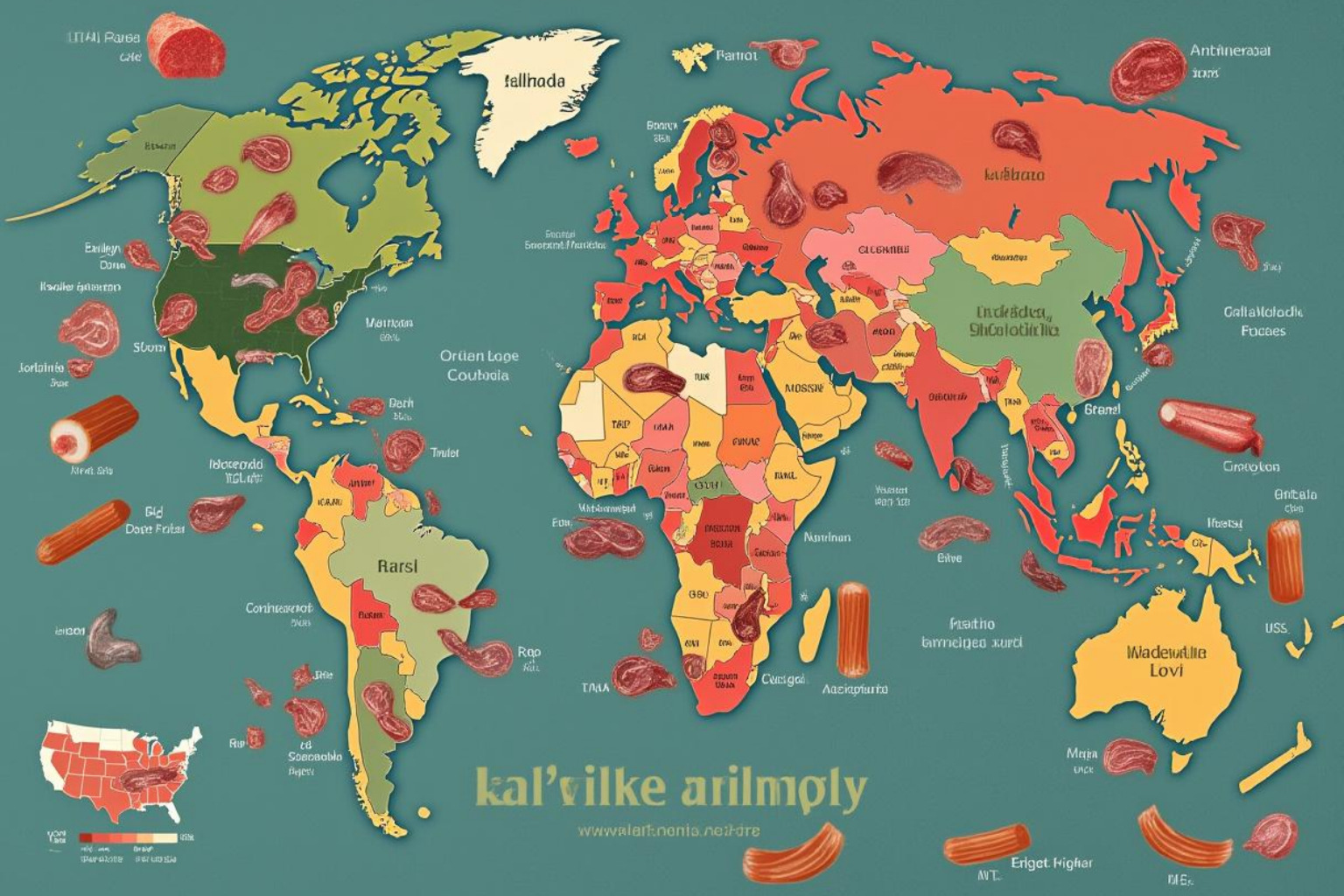
The trivia surrounding mortadella is as rich as its flavor. Back in the 16th century, this delicate sausage was actually more expensive than prosciutto and considered a luxury reserved for the wealthy elite. Fast-forward to 1971, when Italian screen legend Sophia Loren starred in “La Mortadella,” a comedy about smuggling the famous sausage into the United States during the import ban.
Even classical composer Gioachino Rossini was a devoted fan, regularly featuring mortadella at his legendary dinner parties. The man who gave us “The Barber of Seville” clearly knew good food when he tasted it!
Modern Sustainable Production Trends
Today’s top mortadella producers are embracing sustainability without compromising on quality. Many artisanal makers now use energy-efficient ovens to reduce their carbon footprint while maintaining the precise temperature control that makes great mortadella possible.
Locally sourced pork has become increasingly important, giving producers better traceability and supporting regional farming communities. Perhaps most importantly for health-conscious consumers, many premium mortadellas now feature minimal additives—often completely gluten-free, lactose-free, and free from trans fats and artificial preservatives.
This shift toward cleaner production methods means you can enjoy authentic mortadella while feeling good about what you’re eating and its impact on the environment.
Frequently Asked Questions about Mortadella
What does mortadella taste like?
Mortadella delivers a wonderfully rich, savory pork flavor that’s both familiar and sophisticated. The first thing you’ll notice is its gentle, buttery richness—nothing harsh or overly salty. If your mortadella includes pistachios, you’ll taste a subtle nutty sweetness that perfectly complements the pork.
The spicing is delicate rather than bold. Traditional black pepper adds a whisper of warmth, while other aromatics like myrtle berries or coriander create layers of flavor without overwhelming your palate. What makes mortadella truly special is how those visible fat cubes melt on your tongue, creating an incredibly creamy, velvety mouthfeel that’s unlike any other deli meat.
Think of it as the difference between a fast-food burger and a perfectly prepared steak—both are meat, but the experience is worlds apart.
How long does mortadella last once opened?
Once you’ve opened your mortadella and had it sliced, you’ll want to enjoy it within 7 days for the best flavor and texture. The key is proper storage—wrap it tightly in plastic wrap or store it in an airtight container in your refrigerator.
Keep an eye on freshness indicators. If your mortadella starts to look slimy, develops an off smell, or changes color significantly, it’s time to say goodbye. High-quality mortadella should maintain its beautiful pink color and fresh aroma throughout those seven days.
Pro tip: If you’re buying from a deli counter, only slice what you plan to use within a week. Whole, unsliced mortadella keeps much longer than pre-sliced pieces.
Can I freeze mortadella without ruining the texture?
Yes, you can freeze mortadella, though there are some tricks to doing it right. The good news is that freezing won’t make it unsafe—it can extend your mortadella’s life for up to 2 months.
Here’s how to freeze it properly: slice or portion your mortadella before freezing, then wrap each portion tightly in plastic wrap followed by aluminum foil, or use freezer-safe bags with the air pressed out. This double-wrapping prevents freezer burn and helps maintain quality.
The reality check? Freezing will slightly change that signature silky texture that makes mortadella so special. Those delicate fat cubes might lose some of their creamy melt-in-your-mouth quality. However, frozen and thawed mortadella still works beautifully in cooked dishes like pasta sauces, pizza toppings, or fried cutlets where the texture change is less noticeable.
For the ultimate mortadella experience, fresh is always best—but freezing gives you flexibility when you find a great deal or want to stock up on this Italian treasure.
Conclusion
Mortadella is so much more than just another deli meat—it’s a delicious piece of Italian history that’s been perfecting itself for over 600 years. From its ancient Roman roots to its modern PGI protection, this silky, pink-studded sausage represents everything we love about authentic food traditions that have stood the test of time.
Whether you’re spreading spuma di mortadella on crusty bread, layering thin ribbons onto a charcuterie board, or finding it for the first time at a New York City Italian deli, mortadella opens up a world of flavors that connects us to centuries of culinary craftsmanship. It’s one of those foods that reminds us why taking the time to seek out authentic ingredients makes such a difference in our cooking and eating experiences.
What makes mortadella truly special is how it bridges the gap between tradition and modern dining. Those carefully cubed fat pieces that create the signature polka-dot pattern? They’re not just pretty—they’re the result of generations of Italian artisans perfecting their craft. The gentle spicing, the velvety texture, the way it melts on your tongue—every bite tells the story of Bologna’s proud culinary heritage.
At The Dining Destination, we believe that exploring foods like mortadella is one of the best ways to find the world’s most treasured culinary traditions. Sometimes the most incredible food trips happen right in your own kitchen, one authentic ingredient at a time.
Ready to explore more incredible flavors from around the globe? Dive into our Best Food Destinations and let your taste buds guide your next culinary journey!
